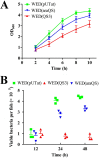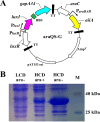In Vivo Programmed Gene Expression Based on Artificial Quorum Networks
- PMID: 25979894
- PMCID: PMC4495192
- DOI: 10.1128/AEM.01113-15
In Vivo Programmed Gene Expression Based on Artificial Quorum Networks
Abstract
The quorum sensing (QS) system, as a well-functioning population-dependent gene switch, has been widely applied in many gene circuits in synthetic biology. In our work, an efficient cell density-controlled expression system (QS) was established via engineering of the Vibrio fischeri luxI-luxR quorum sensing system. In order to achieve in vivo programmed gene expression, a synthetic binary regulation circuit (araQS) was constructed by assembling multiple genetic components, including the quorum quenching protein AiiA and the arabinose promoter ParaBAD, into the QS system. In vitro expression assays verified that the araQS system was initiated only in the absence of arabinose in the medium at a high cell density. In vivo expression assays confirmed that the araQS system presented an in vivo-triggered and cell density-dependent expression pattern. Furthermore, the araQS system was demonstrated to function well in different bacteria, indicating a wide range of bacterial hosts for use. To explore its potential applications in vivo, the araQS system was used to control the production of a heterologous protective antigen in an attenuated Edwardsiella tarda strain, which successfully evoked efficient immune protection in a fish model. This work suggested that the araQS system could program bacterial expression in vivo and might have potential uses, including, but not limited to, bacterial vector vaccines.
Copyright © 2015, American Society for Microbiology. All Rights Reserved.
Figures






Similar articles
-
A quorum sensing-based in vivo expression system and its application in multivalent bacterial vaccine.Microb Cell Fact. 2015 Mar 18;14:37. doi: 10.1186/s12934-015-0213-9. Microb Cell Fact. 2015. PMID: 25888727 Free PMC article.
-
Asd-based balanced-lethal system in attenuated Edwardsiella tarda to express a heterologous antigen for a multivalent bacterial vaccine.Fish Shellfish Immunol. 2013 May;34(5):1188-94. doi: 10.1016/j.fsi.2013.01.027. Epub 2013 Feb 27. Fish Shellfish Immunol. 2013. PMID: 23454428
-
A novel in vivo inducible expression system in Edwardsiella tarda for potential application in bacterial polyvalence vaccine.Fish Shellfish Immunol. 2011 Dec;31(6):1097-105. doi: 10.1016/j.fsi.2011.09.015. Epub 2011 Sep 25. Fish Shellfish Immunol. 2011. PMID: 21964456
-
An evolving perspective on the Pseudomonas aeruginosa orphan quorum sensing regulator QscR.Front Cell Infect Microbiol. 2014 Oct 28;4:152. doi: 10.3389/fcimb.2014.00152. eCollection 2014. Front Cell Infect Microbiol. 2014. PMID: 25389523 Free PMC article. Review.
-
Vibrio fischeri metabolism: symbiosis and beyond.Adv Microb Physiol. 2012;61:37-68. doi: 10.1016/B978-0-12-394423-8.00002-0. Adv Microb Physiol. 2012. PMID: 23046951 Review.
Cited by
-
Site-Directed Mutagenesis to Improve Sensitivity of a Synthetic Two-Component Signaling System.PLoS One. 2016 Jan 22;11(1):e0147494. doi: 10.1371/journal.pone.0147494. eCollection 2016. PLoS One. 2016. PMID: 26799494 Free PMC article.
References
Publication types
MeSH terms
Substances
LinkOut - more resources
Full Text Sources

